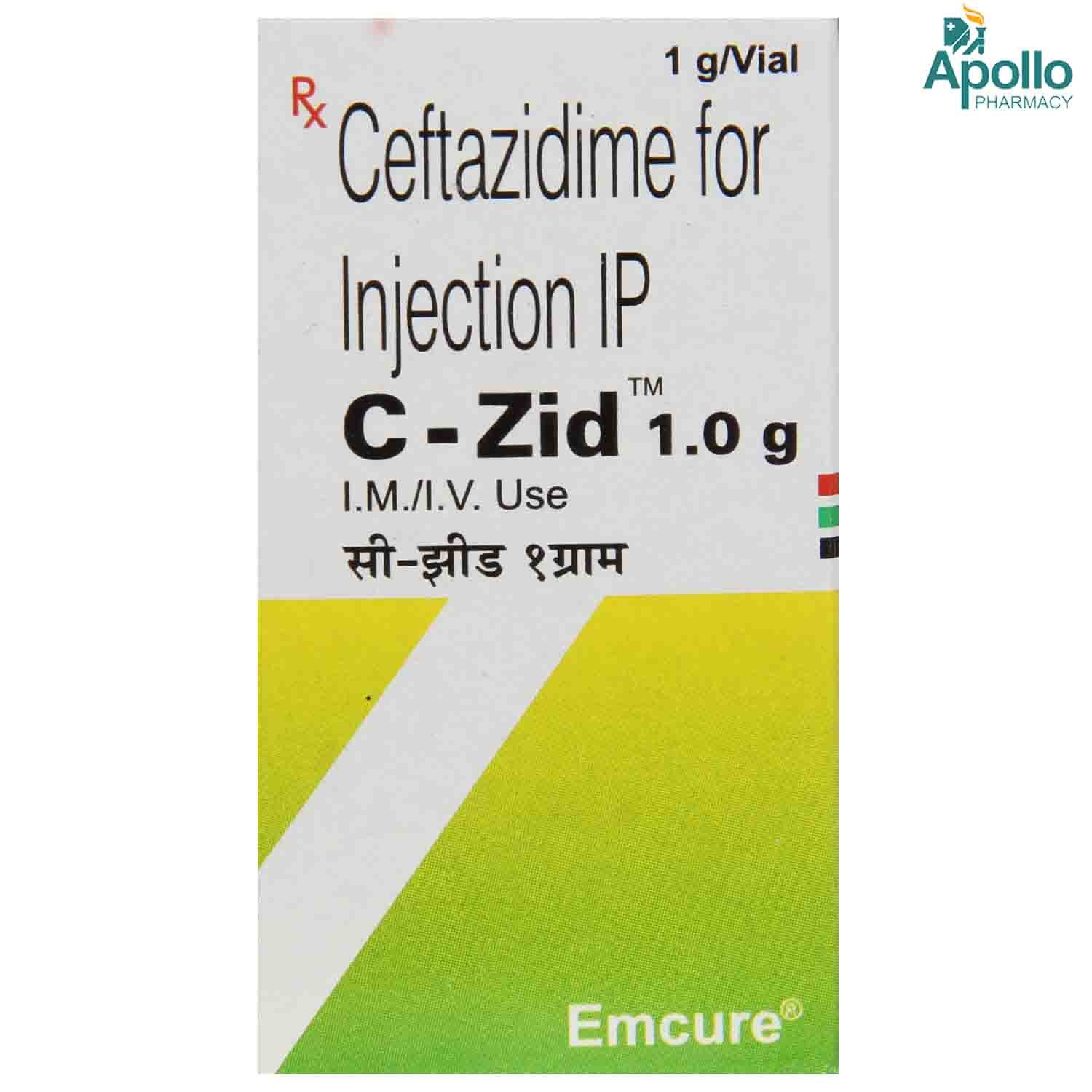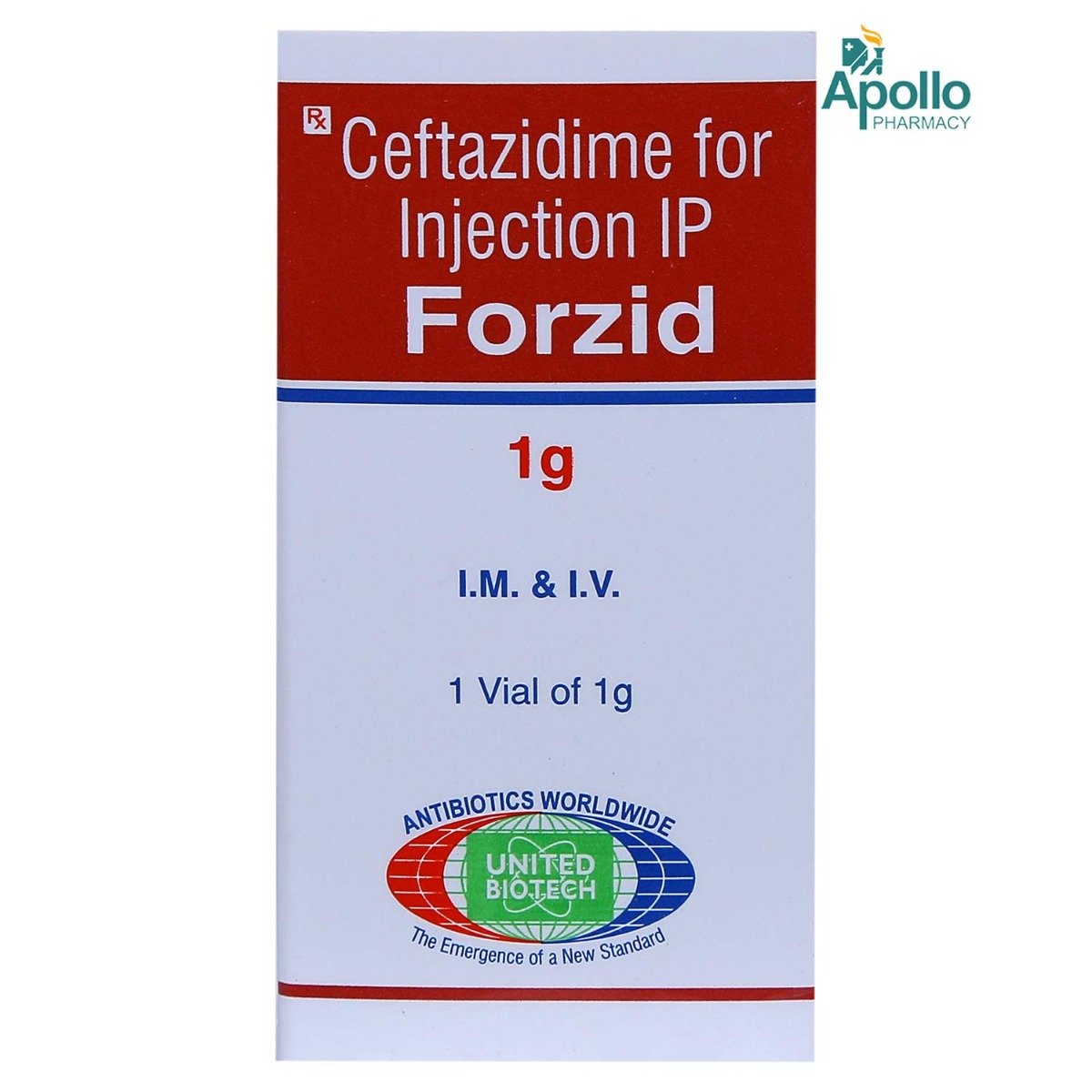Tazid 1 gm Injection
MRP ₹238
(Inclusive of all Taxes)
₹35.7 Cashback (15%)
know your delivery time
Provide Delivery Location
Composition :
Manufacturer/Marketer :
Consume Type :
Expires on or after :
Return Policy :
NPPA :

Secure Payment

Trusted by 8 Crore Indians

Genuine Products
Therapeutic Class
Country of origin
Manufacturer/Marketer address
Author Details
We provide you with authentic, trustworthy and relevant information
FAQs
Disclaimer
Alcohol
Safe if prescribed
The interaction of Tazid 1 gm Injection with alcohol is unknown. Please consult a doctor before consuming alcohol while using Tazid 1 gm Injection.
Pregnancy
Consult your doctor
Tazid 1 gm Injection is a category B pregnancy drug and is given to pregnant women only if the doctor thinks benefits outweigh risks. Please consult a doctor if you are pregnant or planning for pregnancy.
Breast Feeding
Consult your doctor
Tazid 1 gm Injection may be excreted in human milk in small amounts. Therefore, it is given to breastfeeding mothers only if the doctor thinks benefits are greater than risks. Please consult a doctor if you are breastfeeding.
Driving
Safe if prescribed
Tazid 1 gm Injection may cause dizziness. Therefore, avoid driving if you feel dizzy after taking Tazid 1 gm Injection.
Liver
Consult your doctor
Take Tazid 1 gm Injection with caution, especially if you have a history of Liver diseases/conditions. The dose may be adjusted by your doctor as required.
Kidney
Consult your doctor
Take Tazid 1 gm Injection with caution, especially if you have a history of Kidney diseases/conditions. The dose may be adjusted by your doctor as required.
Children
Safe if prescribed
Tazid 1 gm Injection should be used in children only in doses as prescribed by a doctor.
Product Substitutes
About Tazid 1 gm Injection
Tazid 1 gm Injection belongs to a class of drugs called antibiotics used in the treatment of several bacterial infections of the urinary tract, respiratory tract, brain, bones and joints, ears, throat, skin, and soft tissue. Bacterial infection is a condition in which harmful bacteria grow in the body and cause infection. It can infect any part of the body and multiply very quickly. Tazid 1 gm Injection does not work against infections caused by the virus.
Tazid 1 gm Injection contains Ceftazidime, an antibiotic that works by interfering with the formation of the bacterial cell wall (a protective covering) that is necessary for their survival. Thereby damaging the bacterial cell wall and killing bacteria.
Tazid 1 gm Injection will be administered by a healthcare professional; do not self-administer. In some cases, you may experience redness and swelling along with a vein, red raised skin rash, which may be itchy, burning, painful, inflammation, or swelling at the site of injection or diarrhea. Most of these side effects of Tazid 1 gm Injection do not require medical attention and gradually resolve over time. However, if the side effects persist or worsen, please consult your doctor.
If you are allergic to Tazid 1 gm Injection or any other medicines, please tell your doctor. If you are pregnant or breastfeeding, please inform your doctor before taking Tazid 1 gm Injection. Drive only if you are alert as Tazid 1 gm Injection may cause dizziness. If you are on a controlled sodium diet, inform your doctor before taking Tazid 1 gm Injection. If you have a widespread rash with peeling skin and blisters, please consult a doctor immediately as these might be signs of Stevens-Johnson syndrome.
Uses of Tazid 1 gm Injection
Medicinal Benefits Mweb
Key Benefits
Tazid 1 gm Injection contains Ceftazidime, a broad-spectrum antibiotic that acts against both aerobic (grow in the presence of oxygen) and anaerobic (grow in the absence of oxygen) gram-negative and gram-positive bacteria. It is used in the treatment of several bacterial infections of the urinary tract, respiratory tract, brain, bones and joints, ears, throat, skin and soft tissue. Tazid 1 gm Injection interferes with the formation of the bacterial cell wall (a protective covering) that is necessary for their survival. Thereby damages the bacterial cell wall and kills bacteria. Additionally, Tazid 1 gm Injection may be used to treat fever due to bacterial infections in patients with low white blood cells count and also to prevent bacterial infections in men during prostate surgery.
Directions for Use
Side Effects of Tazid 1 gm Injection
- Redness and swelling along a vein
- Burning, pain, inflammation or swelling at the site of injection
- Red raised skin rash which may be itchy
- Diarrhoea
Drug Warnings
If you are allergic to Tazid 1 gm Injection or any other medicines, please tell your doctor. If you have kidney problems or diabetes, inform your doctor before taking Tazid 1 gm Injection. If you are pregnant or breastfeeding, please inform your doctor before taking Tazid 1 gm Injection. Tazid 1 gm Injection may interact with certain tests such as glucose (sugar) in urine and coomb’s test (blood test), resulting in unusual results. Therefore, inform the lab technician that you are taking Tazid 1 gm Injection before undergoing any tests. If you are on a controlled sodium diet, inform your doctor before taking Tazid 1 gm Injection. If you have a widespread rash with peeling skin and blisters, please consult a doctor immediately as these might be signs of Stevens-Johnson syndrome. Drive only if you are alert as Tazid 1 gm Injection may cause dizziness. You are recommended to complete the full course of Tazid 1 gm Injection as prescribed by your doctor for effective results.
Drug-Drug Interactions
Drug-Drug Interactions
Login/Sign Up
When BCG vaccine is used with Tazid 1 gm Injection, its effectiveness may be reduced.
How to manage the interaction:
Taking Tazid 1 gm Injection with BCG vaccine is not recommended, but can be taken together if prescribed by a doctor. In case you experience any unusual side effects, consult a doctor. Do not discontinue any medications without consulting a doctor.
Taking the cholera vaccine after or along with Tazid 1 gm Injection may reduce the activity of the vaccine.
How to manage the interaction:
Although there is a possible interaction between Tazid 1 gm Injection and Cholera vaccines, you can take these medicines together if prescribed by your doctor. You should wait at least 14 days after finishing your antibiotic treatment before receiving the cholera vaccine in order to ensure an appropriate immune response. Do not stop using any medications without consulting a doctor.
Taking the cholera vaccine after or along with Tazid 1 gm Injection may reduce the activity of the vaccine.
How to manage the interaction:
Although taking Tazid 1 gm Injection with Cholera, live attenuated can possibly result in an interaction, but it can be taken if your doctor has advised it. You should wait at least 14 days after finishing your antibiotic treatment before receiving the cholera vaccine in order to ensure an appropriate immune response. Do not stop using any medications without a doctor's advice.
Drug-Food Interactions
Drug-Food Interactions
Login/Sign Up
Drug-Diseases Interactions
Drug-Diseases Interactions
Login/Sign Up
Drug-Drug Interactions Checker List
- CHLORAMPHENICOL
- TOBRAMYCIN
- GENTAMICIN
- FUROSEMIDE
Habit Forming
Special Advise
- Regular kidney function tests are recommended, especially in patients with kidney problems while taking Tazid 1 gm Injection so that the dose may be adjusted accordingly.
- If you are about to undergo any blood or urine tests, inform your doctor that you are taking Tazid 1 gm Injection as it may interfere with these tests.
Diet & Lifestyle Advise
- Take probiotics after completing the full course of Tazid 1 gm Injection to restore some healthy bacteria in the intestines that may have been killed. Taking probiotics after antibiotic treatment can reduce the risk of antibiotic-associated diarrhea. Certain fermented foods like cheese, yogurt, kombucha, sauerkraut, and kimchi can help to restore the good bacteria of the intestine.
- Include fiber-rich foods, as they can be easily digested by your gut bacteria, which helps stimulate their growth. Thus, fiber-rich foods may help restore healthy gut bacteria after a course of antibiotics. Whole grains such as whole-grain bread and brown rice should be included in your diet.
- Make sure you drink plenty of water or other fluids every day while you are taking Tazid 1 gm Injection.
- Avoid alcohol consumption as it may increase adverse effects.
All Substitutes & Brand Comparisons
RX
Out of StockNot for online saleEcozid 1gm Injection
Flamingo Pharmaceuticals Ltd
₹94.93
(₹8.54/ 1ml)
96% CHEAPERRX
Out of StockNot for online salePseudocef 1gm Injection
Shreya Life Sciences Pvt Ltd
₹312.71
(₹28.14/ 1ml)
86% CHEAPERRX
Out of StockNot for online saleCefdin 1gm Injection
Marc Laboratories Pvt Ltd
₹250
(₹45.0/ 1ml)
78% CHEAPER







